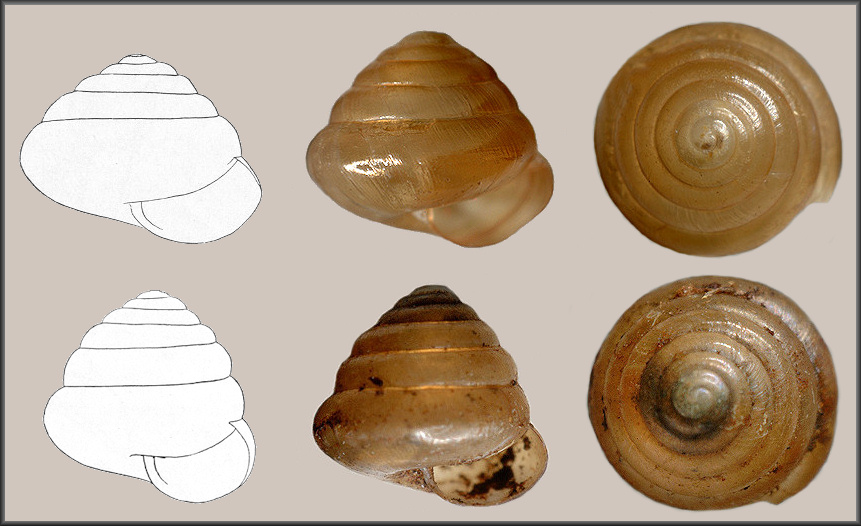|
Figured here are
digital color images (middle and right columns) of
two specimens of E. fulvus from Bennington Co., VT, each in
apertural and in apical view. The "typical" shell in the top row is
2.55 mm in height (H) and 2.85 mm in diameter (D)
using the method of Pilsbry (1939: xi). The shell in the
bottom row right is 3.2 mm in H, 3.4 mm in D, and is unusually
tall. The shell in the top row is considered by a panel of
experts to be more typical,
thus it was
used for the species comparisons on page one of this feature.
Pilsbry (1946: 236; fig. 117C, 117D) showed line drawings
(left column) of two E. fulvus shells: one from Herkimer Co.,
NY (H 2.4 mm, D 3.1 mm; top row); the other, from Buckfield, ME,
(3.4 mm in both H and D; bottom row). Although only differing by
about a half whorl in growth, the two exhibit a stark difference in
apertural view. The H/D ratio is 0.78 vs. 1.0, the ratio of body
whorl to H (BW/H) as measured at the columellar axis: 1.6/2.4 (0.
66) vs. 1.9/3.4 (0.56), and the ratio of aperture (maximum on
an axis parallel to the columella) to H (A/H): 1.1/2.4 (0.46) vs.
1.3/3.4 (0.37) respectively. These morphometric differences are
attributable to variation in the process of whorl "translation"
producing a smaller spire angle, a more convex (vs. trochoid)
profile, and a relatively smaller aperture in the larger shell.
A similar pattern is seen in the in the Bennington Co. E.
fulvus shells, which also differ by about a half whorl: H/D .89
vs. 0.94, BW/H 1.45/2.55 (0.57) vs. 1.8/3.2 (0.52), A/H 1.33/2.55
(0.42) vs. 1.2/2.2 (0.36) respectively. Is this a paradigmatic
process in this species? Evidence indicates that it is, and it
appears to be a generic characteristic, at least for the North
American species (see previous page). In all instances observed by me, the very juvenile
shells that characteristically dominate populations observed in the
field have wider spire angles than larger shells. It is likely that
this "slimming-down" process continues throughout ontogeny, even
affecting giant specimens such as the two 3.4 mm "atypical" ones
discussed here.
Pilsbry, H. A., 1939. Land Mollusca
of North America (north of Mexico) vol. 1 part 1.
Academy of Natural Sciences, Philadelphia. xvii + pp 1-573 + ix.
Dec. 6.
Pilsbry, H. A., 1946. Land Mollusca of North America (north of
Mexico) vol. 2 part 1. Academy of Natural Sciences,
Philadelphia. vii + pp 1- 520. Dec. 6.
 |